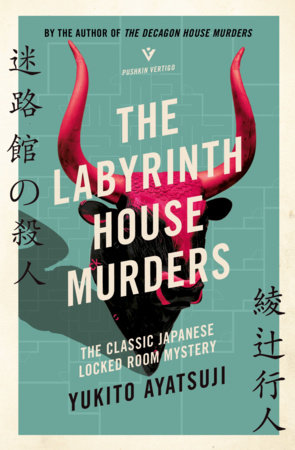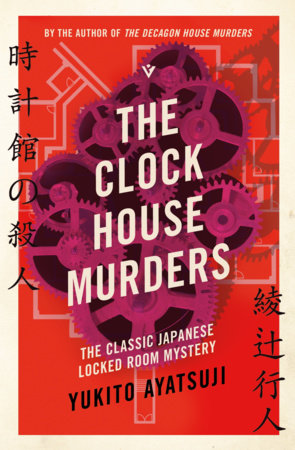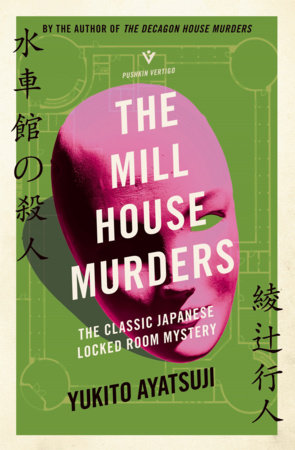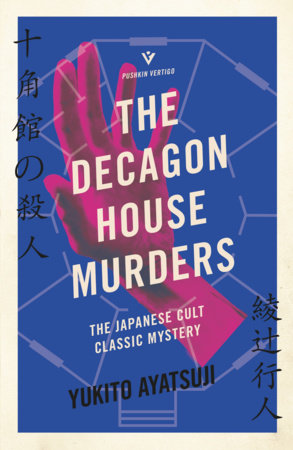Excerpt
The Labyrinth House Murders
P R O L O G U E
It was on Friday, the 2nd of September 1988, that a book was delivered to Shimada, who had been sleeping off a summer cold at home.
Was the colour of the cover lavender, lilac or orchid? He wasn’t sure, but it was a light purple shade.
The book was a common size for paperbacks. In the centre of the cover was a frame in the same colour, tilted at a forty-five degree angle, and inside of it was a picture.
Against a scarlet back- drop, reminiscent of a sea of blood, was the dark head of a bull… The title was printed in relief to the upper right of the frame, on the light purple background, and to the upper left, the name of the author was also printed in relief.
Shishiya Kadomi THE LABYRINTH HOUSE MURDERS
A green strip of paper was wrapped around the cover, a so- called obi, a common practice in Japanese publishing. “Kitansha Novels—September Release” it read, with a tagline printed in Gothic typeface and a white outline around the letters.
AN O R I G I N A L H O N K A K U M U R D E R MYST ER Y!
The Truth Behind the Labyrinth House Murder Case Finally Revealed!
Shimada thought to himself: “Hmph, the marketing slogans for these kinds of books are getting sillier and sillier lately.”
He had heard books weren’t selling much nowadays, but apparently there was still a market for mystery fiction. The number of whodunits on bookshop shelves had been increasing over recent years…
To be honest, there were so many of them now, it was diffi- cult to tell them apart. While it was none of his business, he was starting to worry that readers would eventually just drop murder mysteries entirely because the market was being flooded with mass-produced books of questionable quality.
Shimada looked at the back cover. There was a blurb, a short biography of the author and his photograph. Shimada didn’t think the picture was very flattering.
The Labyrinth House is famous for its complex underground maze. One day, four mystery writers gather at the house, each planning to write a story set inside the bizarre building. But little do they know that they will be caught up in a whodunit themselves! Soon, the writers find themselves cut off from the outside world, and then a series of murders strikes the Labyrinth House… Readers of this superlative mystery must prepare themselves for the most baffling of puzzles, the most shocking of twists! An unrivalled sensation!
Shimada couldn’t help but grin, as he imagined how the author must have felt when his editor came up with this overly dramatic copy.
This was the kind of novel he might pick up in a bookstore, but never buy. He certainly didn’t dislike murder mysteries, but he tended to prefer the translated ones. And while he occasion- ally did read Japanese mysteries, he was always disappointed by them.
But of course, this book was different, as he knew the author very well. It had been sent to Shimada as a gift, so he felt obligated to read it. Especially since it was about the Labyrinth House Murder Case.
Shimada took the book back to his futon, where he lay on his stomach.
He had got over the worst of his fever the previous night. His muscles were still aching slightly, but he was on the mend and beginning to feel eager for stimulation. He could get through a novel this size in a few hours.
He rested his chin on his pillow, and flicked through the book. He had a look at the table of contents. When he saw there was an afterword, he quickly paged to it, as he had a habit of reading afterwords before the main story.
AFTERWORD
These words should really have come at the beginning of the book, but because so few readers are disciplined enough to actually read an “Afterword” after the main story anyway, I thought I might as well put it at the end instead. Please consider the following as a kind of introduction for people who have yet to read the book.
Even now, I still feel somewhat uneasy about publishing this story as a novel. As I assume many of you will have gathered when you saw the title that The Labyrinth House Murders is directly based on a real-life murder case.
It occurred in April 1987, over the same days as in the book. The media made a sensation out of the incident at the time, since it was such a baffling case, and because it occurred at the curious residence of a well-known mystery writer.
However, it is safe to say the press have not managed to provide a proper analysis of whole affair.
That is only to be expected, of course. The incident occurred under highly singular circumstances and all those who knew the truth declined to speak to the press. Even the police were perplexed by this extraordinary case, and while they ostensibly accepted the “truth” that had been revealed, they did not make any definitive announcement about it. The press were therefore restricted to writing vague articles based on non-committal police statements. If the truth about the case was never made public, what gives me the right to write about it, you might wonder. Perhaps
it seems arrogant, or presumptuous of me to do so.
Allow me to make a confession, therefore. I was present when it all happened. I, Shishiya Kadomi, was one of the people in the Labyrinth House in April 1987, when that series of murders occurred there.
I have decided to publish an account of my experience in this format for two main reasons.
The first is that a certain editor very strongly urged me to do so. As for the other reason, perhaps I could say this is my memorial to those who passed away during the tragedy.
That might sound somewhat tasteless, but I know at least some of the victims were great lovers of the unique genre that is the murder mystery. That is why I truly believe that a reconstruction of what happened in the form of a book is the best way to honour those who perished.
However, I doubt many readers will care much about these personal circumstances.
No matter what inspired me to write it, after all, this is nothing more than a murder mystery, a piece of entertainment that allows the reader to escape the boredom of daily life. Of course, that is perfectly fine. No, in fact, that is precisely what this book should be.
Finally, I want to make clear that after careful consideration, I have changed the names of most of the people and places in this novel. I appear in the story myself, but not under my pen-name of Shishiya Kadomi.
So which of the characters is Shishiya Kadomi?
Some readers might be interested in that mystery. But some things are best left a secret.
Summer of 1988 Shishiya Kadomi
Shimada was already familiar with the details of the murders that had occurred in April last year at the Labyrinth House. It had been a truly bizarre affair, but he knew that the matter had, in a certain way, been resolved.
“Recreating a real-life case as a murder mystery, huh?” Shimada opened to the beginning . The face of the author, whom he had not seen for some time now, appeared in his mind. “Well, let’s see what you came up with.”
Shimada started reading…







